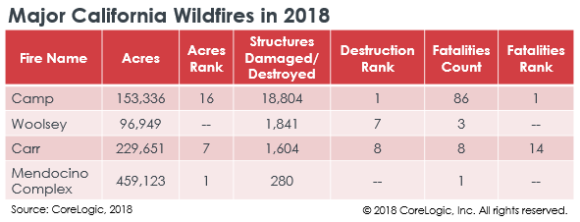

This post is part of a series sponsored by CoreLogic.
The last few months of 2018 were record-setting and heartbreaking for the survivors of wildfires in California.
The Camp Fire in Butte County quickly became the most destructive wildfire on record, far and away surpassing the Tubbs Fire of 2017 with more than 18,000 damaged or destroyed structures. The next seven most destructive California fires combined don’t surpass the Camp Fire’s record level of destruction.
The Woolsey Fire in Ventura County and Los Angeles County took another 1,643 structures, consuming more than 96,000 acres in 2 weeks. Any loss of life to a wildfire is tragic, but the Camp Fire’s 85 related deaths is a record that will hopefully never be surpassed.
Even without these fires, 2018 was significant in terms of destruction and overall fire activity. Earlier in the season, the Carr Fire and Mendocino Complex Fire set 2018 on pace for another year of extreme wildfires in California. The latter broke a record as well, exceeding 2017’s Thomas Fire for most acres burned by a massive margin of more than 150,000 acres as it burned through a total of 459,123 acres.

When we begin to examine the details of what occurred, some patterns emerge. A deadly combination of dry fuels, high wind speeds continuing over several days, and rugged terrain made it hard to fight the Camp and Woolsey Fires. Areas encompassing these fires in Northern and Southern California had very dry conditions, or in the case of Ventura and Los Angeles, were in the midst of a prolonged severe drought.
Indeed, these areas are not unique in their propensity to burn, as both have had upwards of 10 wildfire events at least partially within the most recent burn perimeters since the 1980s.
CoreLogic® analysis in the aftermath of the fires showed that well over 90% of the properties damaged or destroyed in the Camp and Carr Fires were listed as having high or extreme risk from wildfires.
It’s important to understand this risk because homes are lost every single year to wildfires. Wildfires are distinctive because unlike many other perils, they frequently cause total loss of the structure and its contents.
Too often and too late, it can become clear that insufficient insurance had been taken out to reconstruct the home, and this is often a result of inadequate analysis of the reconstruction cost value (RCV). Different from the market value of a home, reconstruction cost is an analysis of the materials and labor it takes to completely rebuild a home from the ground up.
Because of how inflationary pressure can affect this, it’s recommended to reevaluate the RCV every two years, even if using a factor or index, to not only understand what is at stake but to manage the capital necessary to restore a homeowners’ livelihood after a catastrophe. New California regulations, additionally, require a recalculation every other year or the use of a cost index.
With more than 20,000 structures and an estimated $15 billion to $19 billion lost between the Camp and Woolsey Fires alone, it’s clear as we move into 2019 that this risk must be actively managed.
For more information on how to keep up to date on other catastrophes, visit our catastrophe insight and response site Hazard HQ™.